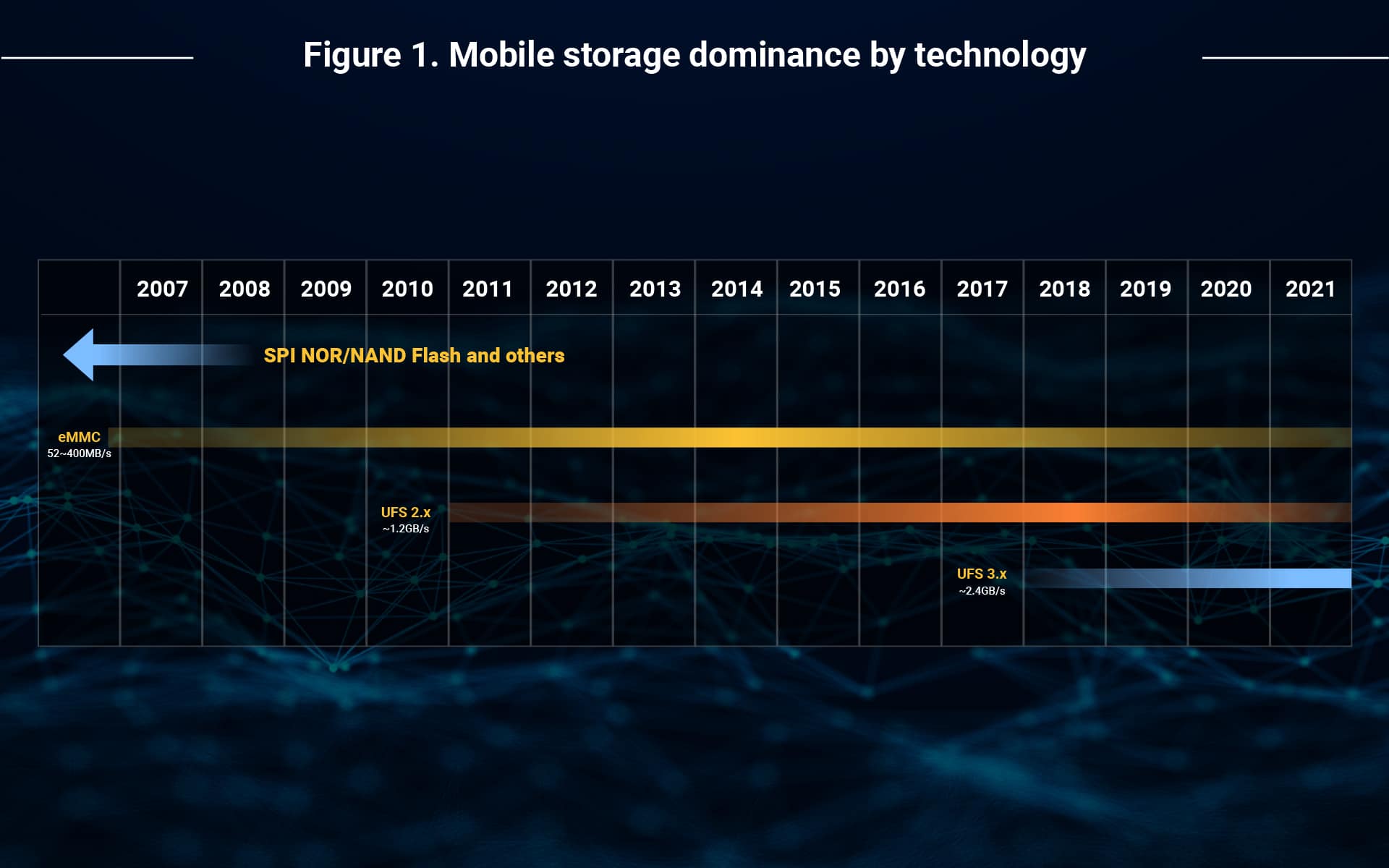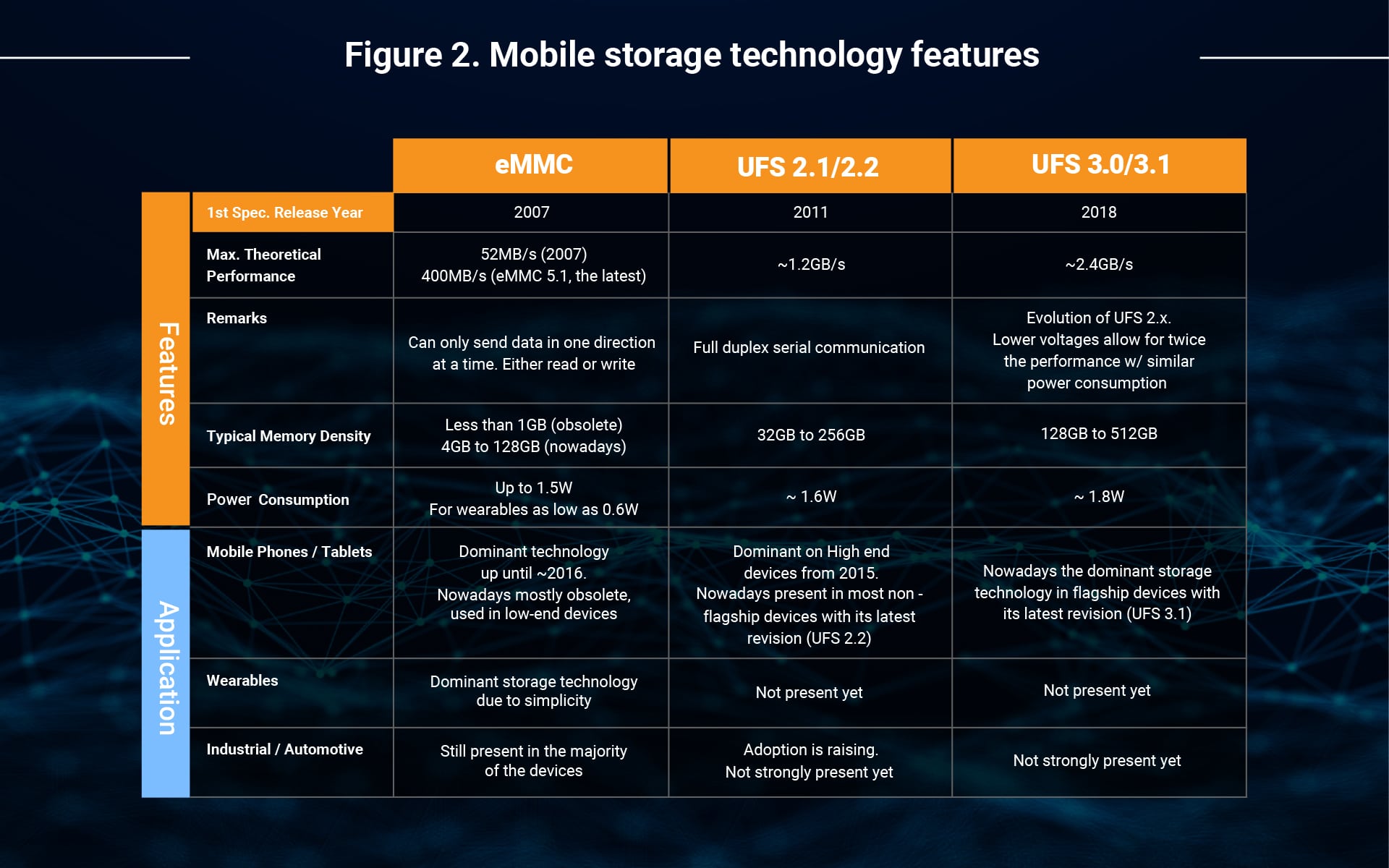An introduction to eMMC, UFS and NVMe BGA SSD
From chunky, brick-sized phones in the 1990s to slim, handheld computers with beautiful touchscreens and gigabit internet connection, the evolution of smartphones is the result of extensive integration of its electronic subsystems.
Here, we’ll discuss the evolution of flash memory storage for mobile devices that have paved the way for the most robust, feature-packed consumer smartphones and tablets to date.
Mobile storage in a nutshell
The NAND Flash storage subsystem of mobile devices is composed of multiple memory chips and a NAND flash controller chip, packaged inside a single BGA IC measuring 11.5mm x 13mm. The BGA package is dark graphite rectangle that most people think of as a “chip”. In actuality, the chips are tiny elements inside the BGA package.
The most important performance factors for the industry are data transfer speeds and power consumption. These must be carefully balanced, especially in high-end smartphones, since they must deliver competitive speed, with a very limited power budget, to optimize battery longevity.
The rise of consumer demand for real-time information and the popularity of mobile gaming generates continuous pressure to drive the evolution of these devices.
To help visualize how that reflects on the industry of Mobile Flash Storage, the image and table below illustrate the most important mobile storage technologies, highlighting their features and prevalence over the years.
Embedded MultiMedia Card (eMMC) for mobile device storage
The eMMC is a storage component designed for use in mobile devices. It consumes significantly less power than regular desktop SSDs or spinning disks. It is also significantly smaller than desktop drives.
Although somewhat obsolete today, eMMCs remain present in low-end phones or other devices that prioritize low cost and less complexity such as value segment laptops, smart TVs, IoT devices, and wearables.
The industrial and automotive segments also benefit from the maturity of eMMCs and the pretense of stable, long-term supply chain partners. In fact, Phison still ships a few million PS8200 units per year to some automotive customers, even now in 2021, 11 years after its debut.
UFS: The gold standard in NAND flash storage for mobile devices
By the mid 2000’s, the eMMC interface and protocol started to show signs of age. The half-duplex interface meant it could not perform read and write operations simultaneously. The main culprit holding back eMMC was its use of parallel data bus. By this point most other storage protocols had shifted to serial data bus technology. Modernizing eMMCs and maintaining backwards compatibility would have require more effort than defining a whole new standard.
That is why Universal Flash Storage (UFS) 2.1 came onto the scene in 2010 and eventually stole the show on high-end smartphones around 2016. It delivered a huge increase in performance over eMMCs, sporting a modern physical serial interface, more robust and efficient protocol, while maintaining similar power consumption.
It was the first mobile storage standard to feature a full-duplex serial connection which supports data flowing in both directions simultaneously. Additionally, UFS supports up to two lanes (connections) in each direction, which result in double the data throughput compared to systems using one lane. For example, it was twice as fast as mainstream SATA III SSDs, used in most desktops and laptops back then, and is still popular today.
With the arrival of UFS, mobile devices could finally benefit from storage performance comparable (or superior) to most consumer PCs in the market. Two years later, in 2018, the growth in popularity of mobile gaming combined with the emergency of WiFi6 + 5G standards brought another wave of demand for even more performance on mobile phones.
The storage industry’s response to it was the UFS 3.0, doubling the bandwidth with only a marginal increase in power consumption. Flagship applications focus on UFS 3.1, while mainstream mobile devices (smartphones, VR/AR, tablets, Chromebooks) make use of UFS 2.2.
UFS 3.1 has enabled unprecedented storage performance in mobile devices and can achieve similar bandwidth to PCIe NVMe SSDs. The evolution does not stop there, and consumers continue to expect performance improvements in the near future.
That’s where NVMe BGA SSDs might become the best fit.
NVMe BGA SSDs
BGA SSDs use the Non-Volatile Memory Express (NVMe) protocol to provide data access over the PCIe interface. The PCIe bus is one of the most popular interfaces and can be found on almost every PC and ARM platforms. The BGA SSD shares the same package size as UFS (11.5 x 13mm) and packs a complete NVMe SSD inside it with 2 PCIs lanes.
Phison’s latest BGA SSD is based on the E21T controller in Gen 4 x2 configurations and delivers up to 3.5GB/s of performance. This is 1.5x the performance of the fastest UFS 3.1 in the market.
PCIe iterations are consistently at least one generation ahead. By the time the next UFS (up to 4.5GB/s) surpasses current PCIe Gen4x2 bandwidth, PCIe will most likely raise the bar yet again with
Gen 5×2 (up to 7GB/s).
Given the very tight integration in the mobile device ecosystem, the biggest challenge for the adoption of a different standard is the existence of compatible host platforms (ie: phone CPU). Phison believes in the potential of this solution for mobile storage and has already started mass producing NVMe BGA SSD parts. They have similar cost and power efficiency as the most recent UFS devices.
Though interestingly, some low-end platforms are pushing to retire eMMCs, driving interest in the low-end segment of NVMe BGA. Phison, has also started to explore this territory with a Lite version of its NVMe SSDs. It is designed to offer smaller memory densities, with a strong focus on low power consumption and competitive cost. Ideal for the low-end mobile market.
Phison is a leader in storage for mobile devices
Phison is a leader in the mobile storage industry and offers a wide range of solutions in this market. Earlier, in 2021 Phison partnered with BlackShark (a company from the XiaoMi group) to deliver the 1st BGA NVMe SSD in a smartphone. It was also the 1st time a smartphone featured a storage subsystem significantly faster than UFS 3.1.
Our strengths include:
-
-
- Flexible Business Model – We operate on a business model which allows us to adapt quickly to customer’s needs.
- Expertise – We have extensive know-how and the ability to develop in-house IPs which reduce time to market through vertical integration.
- R&D – We invest significantly in R&D to run more projects in parallel while remaining competitive with cutting-edge technology.
- Vision – Our vision and our planned risk-taking strategy allow us to explore new and innovative technologies.
-
These strengths allow us to reach the market before the competition, giving us a significant head start when new technology becomes widely adopted. By the time competitors release their first product, Phison has already moved to its second or third iteration.
If you’re curious to learn more about other Phison achievements in flash storage for mobile devices, check out other posts on this topic.














